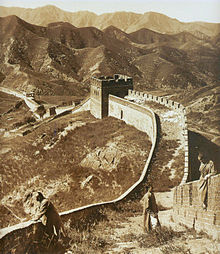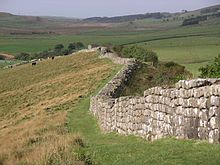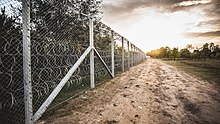Cordon (fortress)

A cordon (also border fortification ) is the structural or landscape design of a border or a border hinterland . It is an elongated system of fortresses or fortifications (walls, fences, ramparts, etc.) that is usually built along a political border of a state territory . This can have protective , custodial or defensive functions for external security or just have symbolic value. Cordon systems were also used to secure the winter quarters for troops .
Basics
The range of possibilities is wide and ranges from early historical planting with shrubs or hedges to fences , walls , ditches and ramparts to large structures with water hazards , mine belts or modern electrically or electronically secured systems.
The word comes from franz. cordon "cord", and generally designates a series of interconnected military posts or a chain of posts for border guarding, for cordoning off localities and larger areas in the event of epidemics and the like.
Part of the formation of a cordon could also be to selectively settle certain population groups in the area to be secured , which could quickly deploy troops against the invading enemy in the event of an invasion or infiltration . These "military settlers" were often granted privileges (e.g. tax advantages , religious freedom , exemption from other military service , cheap or free land) to secure and increase loyalty . Examples are the Austro-Hungarian border guards , parts of the Cossacks or the first Israeli settlements that were initially deliberately built along the border with Jordan .
historical development

United States-Mexico border , Algodones Dunes , California
Protective walls against invading enemies have been known since prehistory. Examples are the Great Wall of China and the Roman Limes . In Europe, the Landwehr method was widespread until the early modern era.
Due to the expansion in this length, this form of attachment causes a fragmentation of the military forces, which is often disproportionate to the military benefit. The cordon is therefore more suitable for deterring a potential aggressor . In the 18th century, cordons were used in particular by the Austrian General Feldzeugmeister Franz Moritz Graf von Lacy in the War of the Bavarian Succession . While the Prussian fortresses proved to be largely useless against Napoleon's mobile warfare in the campaign of 1807 , Wellington was able to make effective use of the lines of Torres Vedras in the Peninsular War of 1811 and thus inflict a severe defeat on France. After the end of the Cabinet Wars, however, the mass armies based on conscription and increasingly mobile warfare generally reduced the advantages of cordons, so that the cordon system was increasingly abandoned from the middle of the 19th century, especially since it offered the opportunity to roll up the line of defense if it broke through . In addition, modern siege artillery with gun barrels made of steel drastically lowered the value of fortification walls. Instead, the areas to be protected were closely monitored, the troops were gathered at central points and the enemy was then met with superior strength in the operational area.
Carl von Clausewitz writes in his work On War :
“The name of the cordon is given to every defense establishment that wants to protect an entire area directly through a series of contiguous posts. We say immediately, because several corps of a large army, positioned side by side, could protect a significant area from enemy penetration without forming a cordon; then this protection would not take place immediately, but through the effect of combinations and movements. It is obvious that a line of defense as long as that which is supposed to directly cover a significant stretch of land can have only a very small degree of resistance. Even with the largest numbers of troops, this would be the case if similar numbers of troops acted against it. The intention of a cordon can only be to protect against a weak shock, be it that the willpower is weak or the force with which the shock can be made is small. The Great Wall of China was erected in this spirit, a protection against the raids of the Tatars. This is the meaning of all line and border defense institutions of the European countries in contact with Asia and Turkey. In this application, there is nothing absurd about a cordon, nor does it appear inappropriate. Of course, this will not be able to prevent all rioting; but they are made more difficult and consequently less frequent, and in conditions like those with Asian peoples, where the state of war almost never ends, this is very important. "
The system was revived trench warfare of the First , the fortifications of the interwar period , and the German Wall projects of the Second World War . While the first major war, which was already modern in terms of weapons technology but was still undeveloped in terms of motorized mobility, led to appalling losses of soldiers without any particular land gain, the projects of the second major war - under the false assumption that the coming war would be the same as the first - according to the Clausewitzian analysis remained largely ineffective.
In the course of the 20th century, the purpose of the cordon was reversed: it primarily served the civilian aspects of migration (e.g. iron curtain with Berlin Wall , border between North and South Korea , border between the United States and Mexico ). This also includes the context of the war on terrorism since the beginning of the 21st century.
Examples (selection)

Well-known cordons in political, geographic and military history :
-
Modern times :
- Barrier fortresses (Netherlands / France, 1709/1713 / 1715–1781)
- Düppeler Schanzen
- Eugeniana fossa
- Lines of Torres Vedras
- Landesfestung Ingolstadt (classical fortress, built 1828–1849)
- Military border and hussar cordon (Austria, Hungary / Ottoman Empire),
- Barrière de fer ( built in France after the Franco-Prussian War (1870/71) )
- Victoria Lines
-
First World War :
- "Western Front" : Verdun , Somme , Chemin des Dames and many more
- " Siegfriedstellung "
- "Southern Front" ( Alpine War )
- 1919–1945:
- Atlantic Wall (built 1942–1944)
- Maginot Line (built 1930-1940)
- "Ostwall" (built 1934–1939)
- Czechoslovak Wall (built 1933-1938)
- " Westwall " (corresponds to "Siegfried Line", built from 1938 to 1940)
- After World War II :
- " Iron Curtain ", see also " Berlin Wall " and " Border fortifications of Czechoslovakia in the Cold War "
- Kashmir conflict
- Current:
- North Korea / South Korea border
- Border between the United States and Mexico
- Israeli barriers to the Gaza Strip and the West Bank
- " Lines of Peace " in Northern Ireland
- Border Republic of Cyprus / Turkish Republic of Northern Cyprus
- Border between Iraq and Saudi Arabia
- Egyptian barriers to the Gaza Strip
- Hungarian border fence
- Border fence near Ceuta
- Border between Syria and Turkey
- Moroccan Wall in Western Sahara
- Border between South Africa and Mozambique
- Border between South Africa and Zimbabwe
See also
Individual evidence
- ^ About the war, left work of General Carl von Clausewitz. Edited by Marie von Clausewitz, Ferdinand Dümmler, Berlin 1832–1834.




